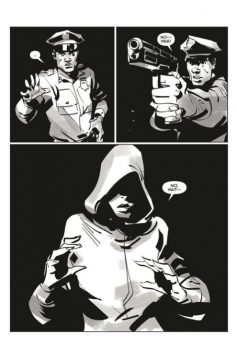Review: Black Cotton #1-3 (Scout Comics)
We’ve seen many comics tackle the heavy subject of racism in the past, from classic X-Men to John Lewis’ March and more recently Charlot Kristensen’s excellent What We Don’t Talk About. Scout Comic’s Black Cotton joins this group by giving us a fresh spin on contemporary racial tensions by swapping the traditional roles with a rich black family coming under fire for their attitudes towards minority whites. But is Black Cotton a tale worth spinning?
 Publisher: Scout Comics
Publisher: Scout Comics
Writer: Patrick Foreman and Brian Hawkins
Artist: Marco Perugini
Price: $2.99 per issue from the Scout Comics Web Store
With Black Cotton, writers Patrick Foreman and Brian Hawkins have brought together elements from contemporary news stories such as the deaths of George Floyd or Breonna Taylor, and given them an interesting narrative twist by reversing the traditional racial roles. Zion Cotton is a black beat cop, who also happens to be the son of Virgina’s richest family. So when he shoots an unarmed white girl, it opens a can of worms that shines a spot light on racial inequality, privilege and police bias.
While we’ve seen this spin before in books like Noughts and Crosses, by using very specific and relatively small scale case, rather than worry about the bigger picture, it gives everything an added resonance. The take on racial privilege and inherent bias seem even more obvious to this white reviewer, when the spotlight is shone on them from the alternate viewpoint and the story is very carefully considered. Forman and Hawkins use enough real life elements to make it feel very real, but also with enough detachment to make it not feel like it has an agenda which could cause it to loose the satirical message.
 Visually it is brought to live by the wonderful Marco Perugini whose work we are still praising in the wonderful Cuddles. As with that book, Marco’s grasp of simple facial expressions and body language help to make a very low action series into a taught and tightly presented story. He has a superb use of light and dark, and his characters just feel effortly natural in every pose. His work feels looser here and when combined with a monochrome colour palette it gives the whole thing a very pulpy feeling, reminding us of Russell Olson’s work in The Black Iris, but also the wonderful March (which is a lofty comparison indeed!). By not using colour, it blurs the lines about the race of the characters, and so adds a level of subtlety to the aesthetics of the book. While the ‘shades of grey’ in the inks and colouring also work as a visual metaphor for the story as well as looking fantastic.
Visually it is brought to live by the wonderful Marco Perugini whose work we are still praising in the wonderful Cuddles. As with that book, Marco’s grasp of simple facial expressions and body language help to make a very low action series into a taught and tightly presented story. He has a superb use of light and dark, and his characters just feel effortly natural in every pose. His work feels looser here and when combined with a monochrome colour palette it gives the whole thing a very pulpy feeling, reminding us of Russell Olson’s work in The Black Iris, but also the wonderful March (which is a lofty comparison indeed!). By not using colour, it blurs the lines about the race of the characters, and so adds a level of subtlety to the aesthetics of the book. While the ‘shades of grey’ in the inks and colouring also work as a visual metaphor for the story as well as looking fantastic.
Because we were able to read these first three issues in one chunk we were able to really get into the story and get an idea of what is happening. However when read as individual issues, the pacing felt a little odd. For example, issue 1 ends just as it gets going, and issue 2 and 3 jump around in time a bit too much for our liking, making the story feel quite disjointed. While we can see why they did this to make the individual issue swork, this is the kind of story which will benefit from being read in one long run, and so this formatting may impact on the flow of the inevitable collected edition – which is where this story should really excel!
Overall Black Cotton is a really smartly written and carefully considered look at contemporary racial tensions. Its flipped narrative makes it a poignant and powerful read, and it’s superbly simple visuals help to strengthen the impact. It is a fantastic example of how comics and politics can intertwine and tell intricate and important stories in unique ways. A really clever and thought provoking read that should develop into something very socially relevant indeed.



October 4, 2025 @ 8:22 pm
Thank you for your sharing. I am worried that I lack creative ideas. It is your article that makes me full of hope. Thank you. But, I have a question, can you help me?
October 8, 2025 @ 12:54 am
Your point of view caught my eye and was very interesting. Thanks. I have a question for you.